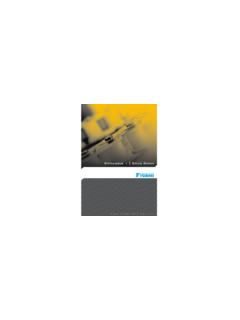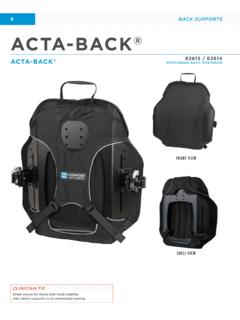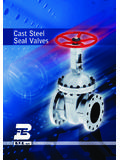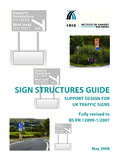Transcription of TSUBAKI CAM CLUTCH BS-F SERIES
1 NEW. TSUBAKI . CAM CLUTCH . BS-F SERIES One-way CLUTCH BACKSTOP Cam CLUTCH Developing new tec TSUBAKI abundant B. Ideal for tough environment Special labyrinth seal mechanism for dusty environment Flexible labyrinth blocked dust and water against cement and mining tough condition. Flexible labyrinth Grease only (Patent pending : JP) (Grease tting). Sealing performance test by cement powder TSUBAKI BS-F Others (Flexible labyrinth) (Grease tting). Special double lip oil seal and multi temperature grease for wide temperature range Ambient temperature range -40 C to +65 C(-40 F to +149 F). Drop in design The narrowest width with I-beam structure makes easy installation for customer's current layout 1 No need to modify a current layout when a customer replaces the BACKSTOP. 2 New conveyor system also has a bene t to save the space and reduce the installation time. 1. hnologies based on ACKSTOP experiences. Ingenious BACKSTOP mechanism Non-rollover cam TSUBAKI original cam design can hold higher backstop torque as well as excessive torque by at area.
2 N m 1,200,000. TSUBAKI . Others Flat area Torque capacity 800,000. 400,000. Bore 0 size 225 250 270 300 360 425 465 mm Torque capacity comparison Cam & roller cage for longer life at overrunning Cam and roller cage orbit at low speed to convey grease from bottom to top continuously. 1 Ideal lubricant condition 2 Wear on the cams is diminished 95 C. Cam Roller C C. 18 C. Cam & roller construction TSUBAKI Cam CLUTCH Roller Ramp CLUTCH Temperature comparison at the same overrunning speed 3 Steps easy connection Step 1 Step 3. Step 2. 2. High speed and Down sizing TSUBAKI BACKSTOP BS-F SERIES can meet the high speed trend of inclined conveyors as well as reducing width with our new improved design. It is easy replacement from customer's current BACKSTOP. r/min mm 400 400. TSUBAKI TSUBAKI . Others Others Width of inner race Over runing speed 300 300. 200 200. 100 100. Bore Bore 0 size 0 size 140 165 200 225 250 270 300 360 425 465 mm 95 115 140 165 200 225 250 270 300 mm Over runing speed comparison Width of inner race comparison Variety of options to satisfy customer demands For details, please contact TSUBAKI .
3 1 Safety cover 2 Oil lubrication Prevent physical injury at operation as well as Easy maintenance dust and water from outside Oil level and condition monitoring 3 CLUTCH Mounting Accessories Shaft collar End plate Shaft key 3. Mounting arrangement BACKSTOP Mounting Arrangements Preventing reverse rotation of inclined or vertical conveyor systems is one of the most common applications for BACKSTOPS. There are many con gurations of conveyors systems that employ BACKSTOPS. This paper presents the most common types and provides examples and calculations needed to properly size BACKSTOP in order to maximize performance and improve safety of the conveying system. *Suggested arrangement may not meet local design standards, please check local design standards. Single and Dual Drives BACKSTOPS for low speed overrunning type are installed directly on the extended head shaft, as shown in Figure 1 and 2. TSUBAKI recommends the single installation of the BACKSTOP to prevent the reverse rotation of head shaft.
4 BACKSTOP BS-F BACKSTOP BS-F. Belt Conveyor Belt Conveyor Torque Arm Motor Speed Reducer Motor Motor Speed Speed Reducer Reducer Figure 1 Figure 2. Tandem Drives When the conveyor arrangement calls for a primary and secondary drive, as shown in Figure 3, the BACKSTOP on the primary drive unit holds the full load. The BACKSTOP on the secondary drive unit holds the back tension from the belt. It keeps belt traction on both conveyor systems. TSUBAKI recommends that the BACKSTOP, having the torque capacity equal to the sum of the primary and secondary motors, be installed on the primary drive unit. The BACKSTOP for secondary drive should be sized from secondary drive motor only. *Suggested arrangement may not meet local design standards, please check local design standards. BACKSTOP BS-F. Belt Conveyor PRIMARY. Motor Speed Reducer BACKSTOP BS-F. SECONDARY. Motor Speed Reducer Figure 3. 4. Selection procedures by motor stall torque BACKSTOP Size Selection Service Factor A backstop by de nition are required to hold back a load from moving in a reverse direction.
5 Care must be taken in calculating the torque requirements and should be based on maximum or worst case conditions and not average/normal loads. Because any failure of BACKSTOP might result in costly damage or injury, care must be exercised to consider all the possible loads and select appropriate service factors. The BACKSTOP needs to be sized for the breakdown or stalled torque of the drive motors. The following table shows typical service factors to be applied when size selecting BACKSTOPS. Required torque for selection = Motor nominal torque Service Factor Motor Stalled Torque = Motor maximum torque experienced with no shaft rotation Maximum Stalled Torque or Breakdown Service Factor torque % of Normal Motor Rating 175% 200% 250% 300% Load sharing The BACKSTOP has no backlash, two BACKSTOPS can share the total calculated torque 50%/50% theoretically. However, we have to consider Load sharing factor because Load sharing of BACKSTOPS on conveyors with multiple drives is a key factor.
6 Dual Drive Application For dual drive to a single head shaft, if the required backstop capacity is in excess of the listed capacity in the catalogue, a twin arrangement of BACKSTOP Cam CLUTCH is the solution, as shown in Figure 4. And we have to consider Load sharing factor . In this arrangement, load sharing factor becomes for two BACKSTOP Cam Clutches For proper load sharing the torque arm gap clearance should be reduced to a zero gap, thus no swing of the torque arm before the cams in both BACKSTOPS prevent the inner race from rolling back. BACKSTOP BS-F BACKSTOP BS-F. Belt Conveyor Motor Speed Reducer Speed Reducer Motor Figure 4. 5. Selection procedures by backstop torque INFORMATION FOR SELECTION. Selection Procedure 1 Determine the mode of operation 2 Refer to the selection procedure corresponding to the mode of operation For Belt Conveyors (Short inclined yard conveyors) Note: Selection Procedure: f = Friction coe cient of rollers = (normally used).
7 1. Calculate the power to move an empty belt and idlers: (P1) W = Weight of moving parts of the conveyor in the unloaded P1 = f W V + 0 (kW) condition (kg/m). 367. 2. Calculate the power to move a loaded belt horizontally: (P2) Use the values from the table below. P2 = f Qt + 0 (kW) Width of Belt (mm) 400 450 500 600 750 900. 367. 3. Calculate the power to move the load vertically: (P3) Estimated Weight: W 28 30 53 63. P3 = h Qt (kW) Width of Belt (mm) 1,050 1,200 1,400 1,600 1,800 2,000. 367. 4. Calculate the back stop power: (Pr) Estimated Weight: W 80 90 112 125 150 160. Pr = P3 (P1 + P2) (kW). V = Velocity of conveyor (m/min). 5. Calculate the back stop torque: (T). Qt = Max. possible load (tonnes/hour). T = 9550 Pr SF (N m). N h = Total lift (m). 6. Select the proper CLUTCH which satis es the calculated backstop torque. = Horizontal distance between head pulley and tail pulley (m). 0 = Modi cation coe cient for . BACKSTOP BS-F = 49 m (normally used).
8 Belt Conveyor N = Shaft speed (r/min) on which the CLUTCH is mounted. SF = Service factor Torque Select service factor from table below: Arm SF Service condition Motor Backstopping: Several times a day Speed Reducer Backstopping: More than several times a day Selection procedures for bucket elevator For Bucket Elevators Note: Selection Procedure: L = Total lift (m). D = Pitch circle dia. of head sprocket (m). 1. (L + D) Qt D 9800 Qt = Possible maximum load (tons/hour). T= SF (N m). 120 V. V = Velocity of conveyor (m/min). 2. Select the correct CLUTCH which satis es the calculated backstop torque (T). SF = Service factor BACKSTOP BS-F Use the values from the table below. SF Service condition Chain and Sprocket Several times a day Torque More than several times a day Arm Bucket Motor Speed Reducer Note: For the conveyor types other than those in the above examples, calculate the backstop torque accordingly. Always allow for the maximum possible load in your calculations, since backstopping often occurs when the conveyor is loaded above its normal loading capacity.
9 6. Capacities and Dimensions X. 12 13. O Y. K. B. Z. V. B/2 D. 11 J. 10. 4 E. 3. 2. G. H. A. C. L. F. G. 7. 5 Section X-O-Y-Z-V. 8. 9. 6. 1. Parts name 1 Inner race 4 Thrust bearing 7 Torque arm 10 Labyrinth ring 13 Cotter pin 2 Outer race 5 Side plate 8 Pin 11 Socket plug 3 Cam cage 6 Labyrinth plate 9 Oil seal 12 Air breather 7. Capacities Max. Mass Torque Overrunning Bore range Drag (kg) Amount of Size capacity speed (mm) torque grease (N m) (r/min) (N m) Within Torque arm Without Torque arm (kg). Inner race Min. Max. BS85F 6,760 300 60 85 8 43 40 31 28 BS95F 8,940 300 70 95 10 52 48 37 34 BS115F 16,300 300 80 115 15 82 76 59 53 BS140F 24,400 300 90 140 20 114 104 84 74 BS165F 44,100 300 100 165 34 174 159 118 103 BS200F 61,700 180 100 200 44 263 235 185 157 BS225F 102,000 150 150 225 74 489 439 386 336 BS250F 147,000 135 175 250 93 692 635 556 499 BS270F 192,000 125 200 270 98 889 828 692 631 BS300F 345,000 115 230 300 108 1,300 1,230 1,050 973 BS360F 489,000 100 250 360 157 1,870 1,750 1,580 1,460 BS425F 735,000 85 325 425 216 3,080 2,890 2,610 2,420 BS465F 980,000 80 350 465 245 3,770 3,510 3,160 2,900 Dimensions All dimensions are in mm.
10 Size A B C D E F G H *J *K *L. BS85F 107 210 105 151 106 120 127 813 76 64. BS95F 107 230 112 161 120 120 4 127 914 102 71. BS115F 127 270 127 181 142 135 4 149 1,270 102 71. BS140F 127 320 134 170 142 4 151 1,422 127 76. BS165F 141 360 134 209 142 4 169 1,676 152 91. BS200F 150 430 142 284 251 150 4 178 1,829 203 106. BS225F 257 500 203 325 270 268 293 1,981 254 118. BS250F 247 600 229 385 300 272 283 2,083 305 127. BS270F 267 650 254 415 344 280 13 303 2,235 305 140. BS300F 278 780 273 490 430 286 320 2,388 381 143. BS360F 292 930 278 585 490 286 4 345 2,540 457 152. BS425F 380 1,030 396 645 600 404 4 433 2,743 508 162. BS465F 410 1,090 417 690 600 432 474 3,048 610 184. Notes: Torque arm dimensions are imperial base. Please contact TSUBAKI for metric torque arm dimensions. Model name BS 300 F 280 J. Model name Bore size in mm Keyway BS : BACKSTOP 280 : 280mm H7 J : JIS B1301-1996, ISO R773. 300 : Size F : F SERIES 8. Installation and Usage For details, see the manual supplied with the product.














